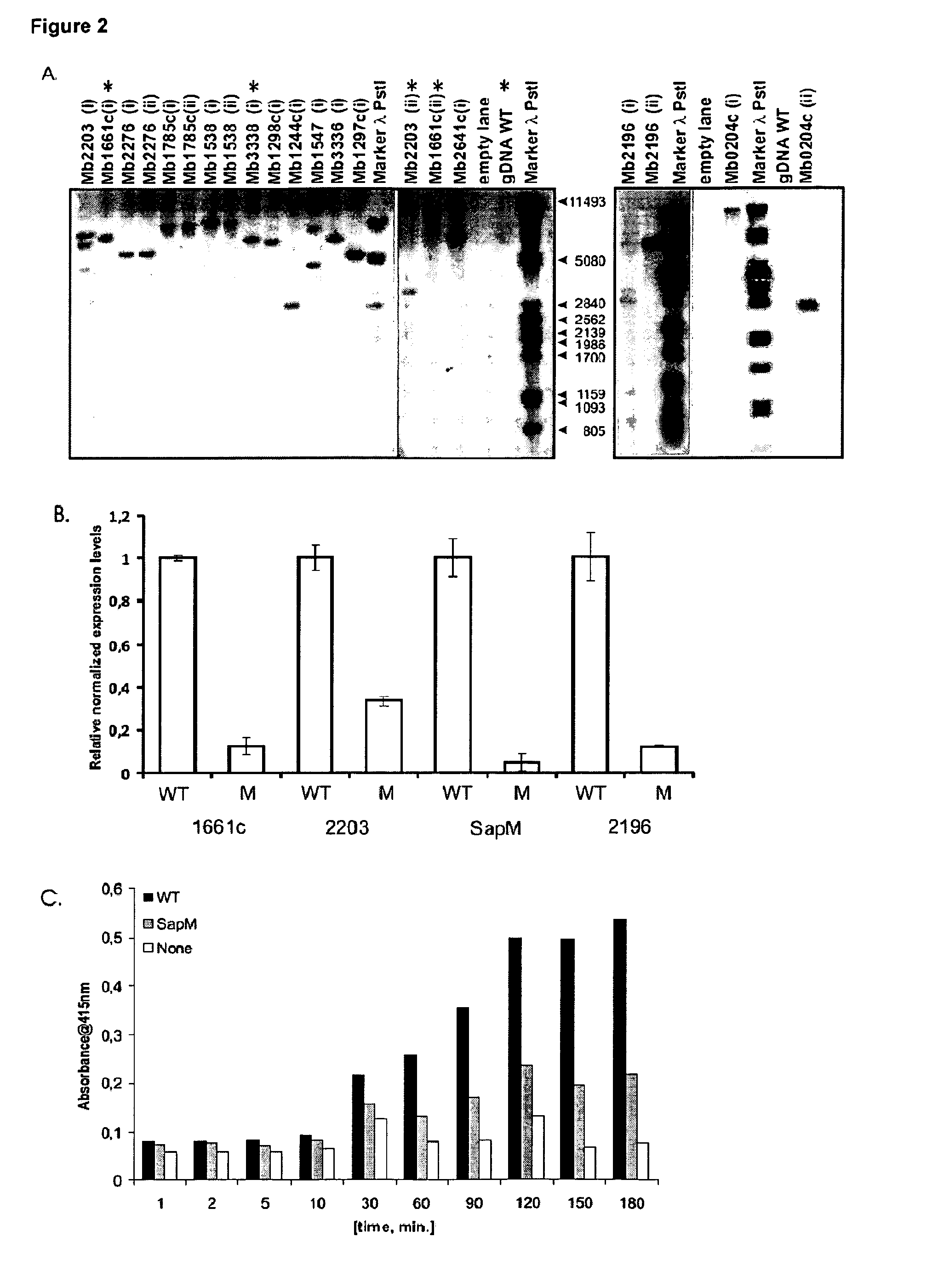Mycobacterium mutants for vaccines with improved protective efficacy
a vaccine and mycobacterium technology, applied in the field of vaccines, can solve the problems of poor homologous recombination efficiency, affecting the safety of vaccines, and requiring work in costly high-risk laboratories, so as to improve vaccine efficacy, prolong survival, and improve immune response.
- Summary
- Abstract
- Description
- Claims
- Application Information
AI Technical Summary
Benefits of technology
Problems solved by technology
Method used
Image
Examples
example 1
Generation and Screening of M. bovis BCG Mutants
[0117]Transposon delivery by mycophages is a highly efficient method for the generation of saturation-mutagenesis libraries of mycobacteria.(54) The method makes it possible to generate a wide variety of mutants in an isogenic background, which is ideal for comparison of the effects of different gene mutations. The insertion of the transposon into a gene most often leads to its inactivation and reversion frequencies are usually very low.(47) The transposon can also be used to deliver additional markers like antibiotic resistance genes. It also allows for the transposon flanking genomic regions to be amplified and identified by sequencing.(27) Transposon mutagenesis has been successfully used in both fast and slow-growing mycobacterial strains.(1, 10, 32, 51) Here, we have created a 96×96 clone, ordered M. bovis BCG transposon insertion mutant library using the Himar1-derived minitransposon delivered by the temperature-sensitive Mycomar...
example 2
Biochemical Characterization of Transposon Insertion Mutants
Southern Analysis for Confirmation of Single Transposon Insertion
[0121]The sequence-confirmed mutants were further characterized by Southern blotting with the full-length transposon as probe, to confirm the presence of a single transposon insertion in the genome. This is essential in order to ensure that the observed phenotype of a mutant is due to a transposon insertion, leading to the inactivation of the gene of interest alone. Apart from three mutants (FIG. 2, Panel A), all the rest showed a single transposon insertion.
Mutants in Mb1661c, Mb2203, Mb2196 and SapM
[0122]We obtained two mutants each for genes Mb1661c, Mb2203 and Mb2196 in our library screen. One of the mutants for the gene Mb2203 and for Mb2196 showed multiple transposon insertions when analyzed by southern blot analysis and was removed from further use. Among the two mutants for gene Mb1661c, we decided to work with the mutant where the insertion of the tra...
example 3
Protective Efficacy of M. bovis BCG Wild-Type Versus Mutant SapM::T (Mb3338::T), Mb2203::T, Mb1661c::T and Mb2196::T in BALB / c Mice
[0133]BALB / c mice were vaccinated subcutaneously with 105 CFU of the parental or mutant M. bovis BCG strains. Three months post-vaccination, animals were intravenously infected with 5×104 CFU of luminescent M. tuberculosis H37Rv. Mice were sacrificed two, four, and eight weeks post-infection and the number of bacteria in spleen and lungs was determined by luminometry. Both parental and three mutant BCG strains offered significant protection against M. tuberculosis as indicated by ten- to 100-fold reduced numbers of bacteria in spleen and lungs as compared to unvaccinated TB infected mice (the Mb2196 mutant is currently being tested in this setting and is not yet included) (FIG. 4, Panel A and FIG. 5). In spleen, there was no difference in efficacy between the parental and mutant strains (FIG. 5), whereas in lungs, a significantly lower number of bacteria...
PUM
| Property | Measurement | Unit |
|---|---|---|
| survival time | aaaaa | aaaaa |
| survival time | aaaaa | aaaaa |
| survival time | aaaaa | aaaaa |
Abstract
Description
Claims
Application Information
 Login to View More
Login to View More - R&D
- Intellectual Property
- Life Sciences
- Materials
- Tech Scout
- Unparalleled Data Quality
- Higher Quality Content
- 60% Fewer Hallucinations
Browse by: Latest US Patents, China's latest patents, Technical Efficacy Thesaurus, Application Domain, Technology Topic, Popular Technical Reports.
© 2025 PatSnap. All rights reserved.Legal|Privacy policy|Modern Slavery Act Transparency Statement|Sitemap|About US| Contact US: help@patsnap.com



